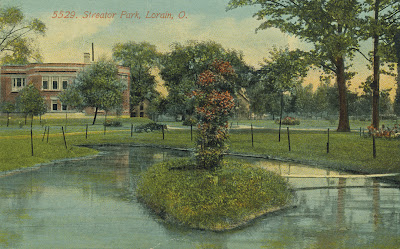And below is the text of the article itself. It's interesting because since the article is in the Lorain Journal, it points out two specific aspects of the power plant that would be of interest to Lorainites: one is at the beginning of the article and one is at the end.
****
TURBINES OF GREAT STATION READY TO TURN–––––
$15,000,000 Structure to Generate Current for First Time
–––––
IS THIRD OF LINE
–––––
Lorain Assured of Steady Supply of Power When Operations Start
The Avon power plant of the Cleveland Electric Illuminating Co., located five miles east of Lorain, will go into operation August 4, according to announcement today by Robert Lindsay, president of the utility.
Wheels of the immense plant representing an initial cost of $15,000,000 and initial capacity of 90,000 horsepower, will be set in operation by Charles F. Brush, Cleveland, inventor of the Brush electric lamp.
Started in 1925
Construction of the plant, which is regarded as one of the most important industrial developments in the history of Northern Ohio, was started March 16, 1925. When the additions are added to the building and the ultimate capacity of 400,000 horsepower is reached, the station will be the world's largest steam electric plant under one roof.
The ultimate cost of the plant will be $30,000,000.
Members of the industrial development committee and the public utility committee of the Cleveland chamber of commerce, members of the Cleveland city council, educators, engineers, newspaper men, public utility representatives and others have been invited to attend for opening.
"This occasion," said Lindsay, "marks the inauguration of one of the latest developments in electrical generation on a large scale. The plant represents the most advanced engineering practice in the production of electricity by coal and steam in its design, both as a factor and unit in the illuminating system."
Third of Chain
The Avon plant is the third largest power plant to be built by the Cleveland Electric Illuminating Co. The other two are located in Cleveland. One, the lake shore station at E. 70th St. and the lake has a capacity of 384,000 horsepower and is at present, the largest steam electric plant under one roof.
The new plant is connected is connected with the lake shore station by a 132,000 volt steel tower transmission line, more than 30 miles in length, which surrounds the central and west part of Greater Cleveland with a belt of power. The plant is also hooked onto the high transmission lines of the Ohio Public Service Co. at Lorain and assures Lorainites of uninterrupted electrical service.
Rushed to Completion
According to Lindsay, the initial installation of 90,000 horsepower at Avon has been rushed to completion because of the rapid increase in the demand for electricity. The illuminating company generated in excess of 1,055,000,000 kilowatt hours, in the 12 months ending June 20, 1926, he stated.
The plant is tied in with a super power network serving northern and eastern Ohio, from the lake to the Ohio river and embracing many industrial cities whose development is one of the world's wonders.
Lorain Man Had Part
A Lorain man, W. A. Trigalet, 800 6th St., supervised installation of the boilers – the largest in the world – giant turbines which will produce electricity on August 4. These boilers use pulverized coal for fuel.
Brush, who is to set the wheels of the Avon plant in operation, constructed the first electric motor to be used to drive street cars.



















































